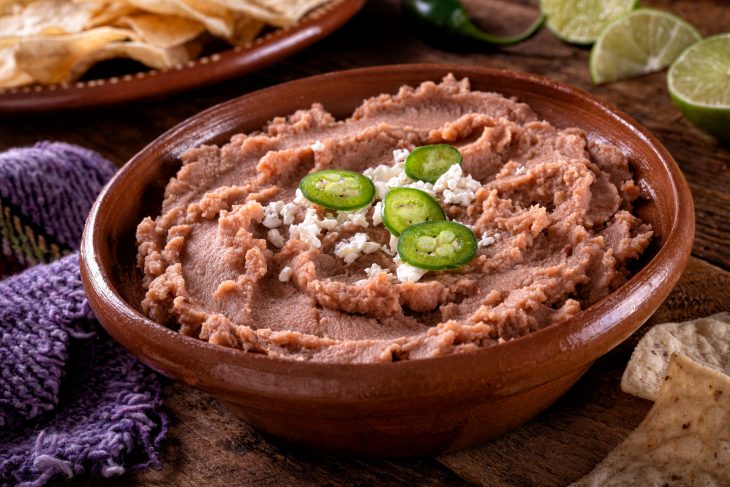
Refried beans are a popular side dish typically associated with Mexican cuisine and have been savored for hundreds of years. Not only are they incredibly flavorful but they come packed with essential nutrients that your body needs! From protein and fiber to carbohydrates and iron, there’s an abundance of vitamins in refried beans that make them an amazing addition to your meal. So if you want more information on the health benefits of these delicious little bites, read on as we delve into all the essential nutrition facts about refried beans!
High in Fiber
Refried beans are rich in dietary fiber, which helps with digestion, weight management, and maintaining healthy blood sugar levels. A half-cup serving contains about 7 grams of fiber.
Good Source of Plant-Based Protein
Refried beans provide a great source of plant-based protein. A half-cup serving contains approximately 7 grams of protein.
Low in Fat
Despite their name, refried beans are low in fat when prepared using a minimal amount of oil or fat. Traditional recipes call for lard, but healthier alternatives like olive oil or even water can be used to reduce the fat content.
Rich in Minerals
Refried beans are a good source of essential minerals such as iron, potassium, and magnesium. These minerals are crucial for various bodily functions like energy production, muscle function, and blood cell formation.
Good Source of B Vitamins
Refried beans contain several B vitamins, including folate, thiamine, and niacin. These vitamins are essential for energy production, brain function, and a healthy nervous system.
Low in Calories
A half-cup serving of refried beans has approximately 120-150 calories. This makes them a healthy and satisfying side dish or ingredient in various recipes.
Gluten-Free
Refried beans are naturally gluten-free, making them an excellent option for those with gluten sensitivities or celiac disease.

Antioxidants
Beans are known for their antioxidant content, and refried beans are no exception. They contain phytonutrients like flavonoids and phenolic acids, which help protect the body against oxidative stress and inflammation.
Cholesterol-Free
As a plant-based food, refried beans are cholesterol-free. This makes them a heart-healthy choice for individuals looking to lower their cholesterol levels.
Sodium Content
The sodium content in refried beans can vary greatly depending on the recipe and preparation. Canned refried beans often contain a high amount of sodium, while homemade versions can be made with less salt for a healthier option.
Vegetarian and Vegan Options
Refried beans can be made vegetarian or vegan by using oil or water instead of animal-based fats like lard.
Nutrient Density
Refried beans are considered a nutrient-dense food because they provide a variety of essential vitamins, minerals, and other nutrients in a relatively low-calorie package. This makes them an excellent addition to a healthy and balanced diet.
Effect on Blood Sugar
Due to their high fiber and protein content, refried beans can help stabilize blood sugar levels by slowing down the absorption of carbohydrates. This makes them a good option for individuals with diabetes or those looking to maintain healthy blood sugar levels.
Weight Management
The fiber and protein in refried beans can help promote satiety and weight management. Consuming foods high in fiber and protein can make you feel fuller for longer, reducing the chances of overeating or snacking between meals.
More About Refried Beans
Versatility in Recipes
Refried beans can be used in a variety of dishes, including tacos, burritos, nachos, and more. They can also be used as a base for dips or spread on toast.
Traditional Mexican Ingredient
Refried beans are a staple in Mexican cuisine and have been enjoyed by various cultures for centuries.

Can Be Made with Different Beans
Although pinto beans are most commonly used in refried beans, other types of beans like black beans, kidney beans, or even chickpeas can also be used to create different flavors and textures.
Shelf Life and Storage
Canned refried beans have a long shelf life, making them a convenient pantry staple. If you’re making homemade refried beans, they can be stored in an airtight container in the refrigerator for up to 5 days or frozen for up to 3 months.
Environmental Impact
Beans, in general, have a lower environmental impact compared to animal-based protein sources. Choosing plant-based protein options like refried beans can help reduce your carbon footprint and support sustainable agriculture.
Conclusion
Refried beans have become a staple in countless homes across the world, transforming from a traditional side dish to a truly versatile ingredient! Their delicious flavor and wealth of essential vitamins make them as healthy as they are tasty – and an easy addition to meals both big and small. Even if you’re unfamiliar with refried beans, we urge you to give them a try and experience their unique goodness for yourself. We’re sure you’ll find these little beans make for a hearty side dish or satisfying meal on their own – so why not get creative in the kitchen today?
Was this page helpful?
Our commitment to delivering trustworthy and engaging content is at the heart of what we do. Each fact on our site is contributed by real users like you, bringing a wealth of diverse insights and information. To ensure the highest standards of accuracy and reliability, our dedicated editors meticulously review each submission. This process guarantees that the facts we share are not only fascinating but also credible. Trust in our commitment to quality and authenticity as you explore and learn with us.


